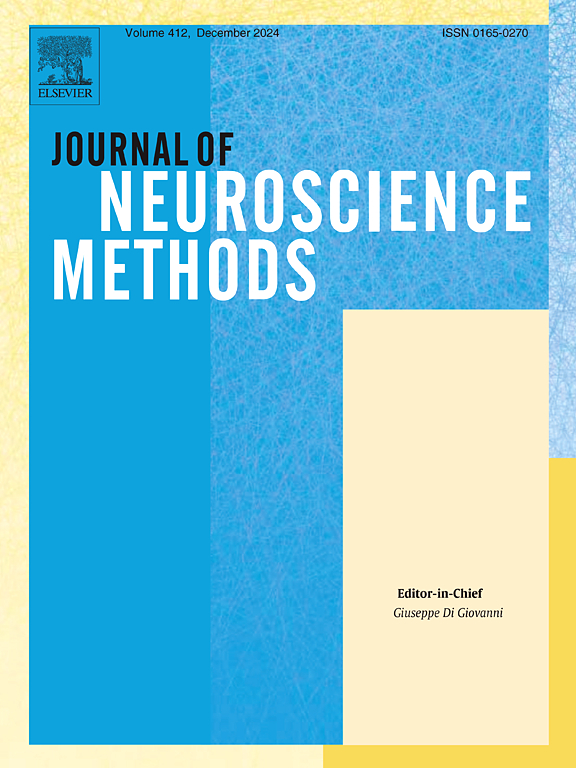Precisely-timed outpatient recordings of subcortical local field potentials from wireless streaming-capable deep-brain stimulators: a method and toolbox
IF 2.7
4区 医学
Q2 BIOCHEMICAL RESEARCH METHODS
引用次数: 0
Abstract
Background
Investigations of the electrophysiological mechanisms of the human subcortex have relied on recording local field potentials (LFPs) during deep-brain stimulation (DBS) neurosurgery. However, the neurosurgical setting severely restricts the research use of these recordings. Recently developed sensing-capable DBS devices wirelessly stream subcortical LFPs in outpatient settings. These recordings have tremendous potential for research. However, synchronizing them with other behavior or neural recordings is challenging, as the clinical devices do not accept digital timing information.
New method
Switching the DBS device on introduces transient yet consistent artifacts in both the LFP and simultaneous scalp-EEG recordings. We use these artifacts as a reference to align these recordings (N = 20). We tested whether the alignment was precise enough to match a ground truth state (large artifacts produced by transcranial magnetic stimulation, TMS), yielded trial-averaged event-locked LFPs, and phase consistency across trials. We further evaluated the consistency of task-related LFPs across outpatient and perisurgical recordings.
Results and comparison with existing method(s)
Previous alignment methods were limited because they relied on inconsistent on/offset features of DBS artifacts caused by ongoing stimulation. Moreover, they only provided limited validation. Our highly precise alignment method showed a maximum deviation of only 8 ms – clearly superior to prior techniques. Furthermore, event-related activity patterns were comparable across outpatient and perisurgical LFP recordings.
Conclusions
We present a method and a MATLAB toolbox that inserts the most precise digital timing information into wirelessly-streamed DBS-LFP recordings to date. By enabling event-related research with high-temporal precision, this method greatly enhances the utility of these recordings.
精确定时门诊记录的皮质下局部场电位从无线流能力的脑深部刺激器:一种方法和工具箱
人类皮层下电生理机制的研究依赖于在脑深部刺激(DBS)神经外科手术中记录局部场电位(lfp)。然而,神经外科环境严重限制了这些录音的研究使用。最近开发的具有传感功能的DBS设备在门诊设置中无线传输皮质下lfp。这些录音具有巨大的研究潜力。然而,将它们与其他行为或神经记录同步是具有挑战性的,因为临床设备不接受数字定时信息。打开DBS设备会在LFP和同时记录的头皮-脑电图中引入短暂但一致的伪影。我们使用这些工件作为参考来对齐这些记录(N = 20)。我们测试了对齐是否足够精确,以匹配基态真态(经颅磁刺激(TMS)产生的大型伪像),产生试验平均事件锁定lfp,以及试验之间的相位一致性。我们进一步评估了门诊和围手术期记录中任务相关lfp的一致性。结果和与现有方法的比较先前的对准方法是有限的,因为它们依赖于持续刺激引起的DBS伪影的不一致的偏移特征。此外,它们只提供了有限的验证。我们的高精度对准方法显示最大偏差仅为8 ms,明显优于先前的技术。此外,与事件相关的活动模式在门诊和手术周围的LFP记录中具有可比性。我们提出了一种方法和MATLAB工具箱,可以将最精确的数字定时信息插入到无线流DBS-LFP记录中。通过使事件相关的研究具有高时间精度,该方法大大提高了这些记录的实用性。
本文章由计算机程序翻译,如有差异,请以英文原文为准。
求助全文
约1分钟内获得全文
求助全文
来源期刊

Journal of Neuroscience Methods
医学-神经科学
CiteScore
7.10
自引率
3.30%
发文量
226
审稿时长
52 days
期刊介绍:
The Journal of Neuroscience Methods publishes papers that describe new methods that are specifically for neuroscience research conducted in invertebrates, vertebrates or in man. Major methodological improvements or important refinements of established neuroscience methods are also considered for publication. The Journal''s Scope includes all aspects of contemporary neuroscience research, including anatomical, behavioural, biochemical, cellular, computational, molecular, invasive and non-invasive imaging, optogenetic, and physiological research investigations.
 求助内容:
求助内容: 应助结果提醒方式:
应助结果提醒方式:


